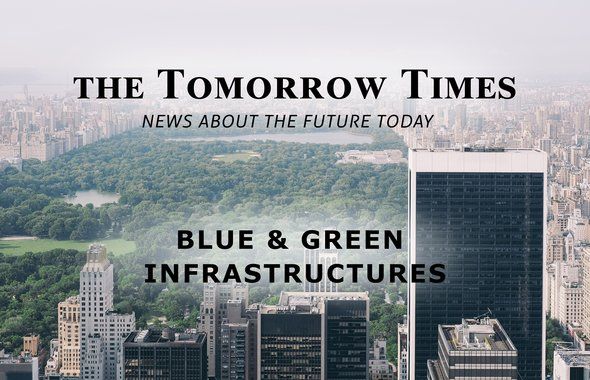This month, the Tomorrow Times explores issues rooted in urban and rural development, and integrated solutions inspired by nature. Imagine infrastructures that enable us to live, work, and play in healthy urban environments, while contributing to the regeneration of the biosphere. While there are no easy paths, diverting from purely “grey” solutions and going back to nature might reveal itself a rather promising starting point.
From cities with negative to positive impact
Hectic urbanization patterns result in greenhouse gas emissions, increasing ecosystem fragmentation, and biodiversity loss. Extreme weather events and climate variations affect our cities and countrysides more than ever before. These trends are increasingly growing the interest of municipalities, designers, and investors towards Nature-based Solutions (NBS) and Blue-Green Infrastructures (BGI).
Integrated approaches to affect many areas at once
Well designed natural and semi-natural areas offer a wide range of ecosystem services to support healthy living environments. These multi-functional solutions can retain stormwater, but also play a key role in counteracting the ‘Urban Heat Island’ effect. They also create an enabling environment for biodiversity to thrive and boost health effects in cities. Landscape architects can use the potential of green elements for regulating air temperature, air quality, water storage and drainage, and noise reduction.
See the Urban Green Infrastructure planning guide for practitioners, from the European Commission funded project GREEN SURGE.
Reconnect with nature as an essential health value
Equally importantly, these infrastructures reintroduce nature in our life. They provide space for regeneration and reconnection, play, and exercise. Biophilic design is the design of spaces integrated with natural elements. This is proven to greatly contribute to mental health, with effects such as stress reduction, increased wellbeing by 15%, productivity by 6% and enhance creativity by 15%.
Ultimately, the multiple functions of these approaches contribute to both the social and economic development of cities.
Follow these periodical monthly updates of tomorrow’s sustainability news today by subscribing to the Tomorrow Times.
Blue & Green Infrastructures
- The strategic plan ‘UN-Habitat’. Published by the UN Economic and Social Council earlier this year, the plan aims at accelerating the achievement of the SDG no. 11 - ‘Sustainable Cities and Communities’. The strategic plan repositions UN-Habitat as a center of excellence and innovation for the exchange of knowledge, experience and best practices related to cities and human settlements.
- Designing BGI: benefits and recommendations for implementation. A major study into BGI has been conducted by Ramboll’s Liveable Cities Labin conjunction with the National University of Singapore, Zeppelin University in Germany, Harvard University, and the Massachusetts Institute of Technology. The research reveals the main benefits of BGI:
- Improves water quality and instils effective stormwater controls
- Increase urban resilience to climate change, for instance, by reducing urban heat island effects and increasing biodiversity
- Create enhanced spaces for recreation and social activities, thereby reducing public health costs, improving wellbeing whilst also attracting residents, businesses and tourism.
- The future of Nature-Based Solutions in the global political agenda. After the undertaken efforts across Europe in the last 5 years to “re-nature” cities, the recently held EU elections are rethinking the future of NBSs policies. UN propositions will be assembled at the Climate Action Summit preparatory meeting will take place on 30 June and 1 July in Abu Dhabi. The vision of the NBS coalition co-leads (China and New Zealand) on the Summit’s theme includes the scaling up of preservation and restoration of forests, land and marine ecosystems, and wetlands.
- Examples of Nature-Based Solutions. Utrecht aspires to optimise and utilise BGI infrastructure as much as possible both to face the consequences of climate change and to address health, sociocultural, economic and environmental challenges. We are glad to be part of this thriving urban fabric. See the city’s action plan, published on the EU Repository of Nature-Based Solutions ‘Oppla’. For more success inspirations, explore this interactive map of case studies or download these city portraits.
Energy & Environment

- Bamboo: Malawi’s unexpected tool for climate change resilience. Natural climate solutions can provide 33%+ of cost-effective climate mitigation needed by 2030. Malawi is restoring 4,5 million hectares of degraded land by 2030, about half the country's total land area, using bamboo to stop landslides and absorb emissions.
- Vacant property transformed into U.S. largest food forest for public. The Atlanta City Council has voted to approve a measure that seeks to transform nearly 7.1 acres of vacant property into a park and food forest that would be open to the public free of charge.
- A worldwide “census” of biomass. Life on Earth weighs more than 80 billion school buses and hardly any of that is animals. Plants count for 82,4% of global biomass, bacteria 12,8%, while animal biomass only 0,4% - of which humans are just 0,01% of the total Earth's life. The study’s numbers are the basis for two new infographics from Our World in Data.
Business & Economy

- UN calls for investments in green infrastructure. UN member states are calling for increased investments in ecosystem-based green, blue and grey infrastructure for disaster prevention and to reduce impacts of climate change. The UN calls for increased investments in ecosystem restoration and protection, with particular focus on lakes, swamps and peatlands to reduce the impacts of water-related disasters.
- Back to basics: how traditional agricultural practices are key to sustainable food production. The example of the Krayan Highlands, a territory of enchanting views and deep cultural traditions. Located in Indonesia, along the border with Malaysia. See also the ‘20 actions guide’ for decision-makers, to transform the food industry and agriculture towards the achievement of the SDGs.
- Google's new study on teamwork effectiveness. The best engineer plus an MBA, throw in a PhD, and there you have it. The perfect team, right? In the words of Julia Rozovsky, Google's people analytics manager, "We were dead wrong". Rozovsky outlines the five key findings for an enhanced team. The most important? They call it Psychological Safety, an environment where you can experiment, fail, succeed, try new things, float ideas and receive honest feedback that doesn't demean your value.
Science, Technology & Design

- Satellite fleet to monitor CO2 in every country. Europe is readying a new fleet of satellites that will monitor CO2 emissions at every point on earth, creating the first worldwide system to independently track polluters, transforming the way carbon emissions are monitored and reported?
- Revolutionizing health surveillance. On the ground floor at the University of Washington, stands a 25,000 CPU supercomputer. All that data-crunching strength was flexed to calculate the most recent iteration of a report called the Global Burden of Disease (GBD); considered one of the largest data science projects in the history of global health.
- World’s smallest power converter. A young team of Danish researchers have developed a new technology for producing power converters sized only a couple of millimetres. The market is huge, including mobile phones, laptops, hearing aids, and wearables. Considering that a smartphone can use up to 15 different power converters, a great amount of space could be saved.
Urban Environment

- How China’s sponge cities are preparing for sea-level rise. Looking to the future, the goal is to repurpose and retrofit cities so that they can absorb more water. 80% of all urban land should be capable of absorbing or reusing 70% of stormwater: the so-called “sponge city” initiative. Transforming the existing building stock requires a long-term planning horizon, with urban restoration, regeneration, and modernization being key drivers - VIDEO.
- The need for urban trees: the San Diego Trees'map project. This initiative includes an interactive map of the whole county showing very specific tree locations and information, including quantified benefits to the region from its trees, as carbon sequestration, water retention, energy saved, and air pollutants reduction.
- Making megacities more livable and sustainable. An interview with Professor Peng Yinghong program director of Energy and Environmental Sustainability for Megacities, a major collaboration between Shanghai Jiao Tong University and the National University of Singapore.
- Gardening helps to fight depression. A growing movement is promoting the role gardening can play in patient recovery and rehabilitation. Connecting with the seasons, to live in nature’s time’ helps mental health. Read how becoming a community garden volunteer helped retired dancer Mikloth Bond manage his paranoid schizophrenia.
Unexpected and Intriguing

- See nature reclaiming abandoned places. This French photographer travelled to more than 700 forgotten sites in 33 countries on four continents.
- A fly-through animation of Notre Dame rebuilt with a roof garden. Miysis Studio has proposed combining a reconstruction of Notre-Dame's spire with a modern glazed and a green roof, where visitors can walk among the trees.
- The veins of America. A stunning new map shows the complex network of rivers and streams in the contiguous United States.
- Beehive fences in East Africa protect farms from elephants. Zoologist Lucy King had a creative idea to protect crops from elephants: bees. It turns out elephants are terrified of bees, the sound of buzzing alone is enough to make elephants leave an area immediately.
Have you seen a news item suited for 'The Tomorrow Times'? Let us know and we'll consider including it in the next edition.
July 3, 2019

